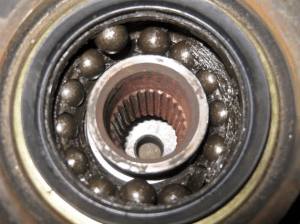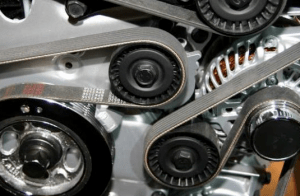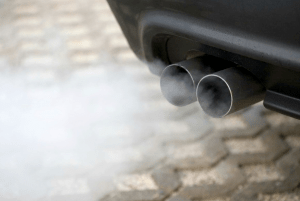
by admin | Jun 7, 2019 | Brakes
Have you been hearing a grinding sound coming from the area of your wheels? Does the sound get louder as you driver faster? Most likely, it’s a bad wheel bearing. If that’s the case, you will want to have it replaced. While a wheel bearing doesn’t typically fail immediately, you don’t want to put off replacing one for too long. Otherwise, you are at risk of having an accident – one that could be serious. This blog post will provide you with more information on how wheel bearings work and how to tell if they are worn out.
A wheel bearing assembly is made up of a set of steel ball bearings that are packed with grease and enclosed in a metal ring that’s called a race. Located at the end of each axle shaft inside a part known as a hub, wheel bearings help reduce friction as your wheels spin. Over time, the wheel bearings begin to accumulate contaminants from the outside and will wear out. When they do, you will start to notice some of the following symptoms:
- You will hear a grinding or grating noise that seems to be coming from one of the wheels. This is definitely the most common symptom that a wheel bearing is bad. It’s not always easy to tell which wheel is making the noise. One thing to remember is that the grinding noise will get louder as you drive faster. The noise is occurring because metal is now grinding on metal.
- The tires may show signs of uneven wear. Yes, there are a lot of things that can cause your tires to wear unevenly. A bad wheel bearing is one of them. Why does this happen? A faulty wheel bearing allows for more “play” in the wheel which causes it to vibrate more. With a bad wheel bearing the uneven wear will show more on one tire.
- You feel more vibration in the steering wheel or your vehicle will pull to one side. Typically, the steering wheel vibration from a bad bearing will be noticed at slower speeds and will get worse as you accelerate.
- The steering may feel “loose.” This is one sign you may not notice on your own. You can check this out by putting your car up on a jack and after grabbing the wheel on opposite sides, attempting to rock it back and forth. If the wheel bearing is okay, the wheel won’t wobble. If the wheel bearing is worn out, you will notice that the tire and wheel assembly will move back and forth.
Can you drive with a bad wheel bearing?
As mentioned, a wheel bearing that is just starting to show signs of a problem isn’t likely to fail right away. That doesn’t mean you should put off having it replaced. Because of the vibrations and extra wheel play, a bad wheel bearing will begin to put pressure on other steering and suspension components. It may end up causing damage to the hub, CV joint, and axle to name a few. Even worse, if left unfixed, a worn wheel bearing could fail completely and cause the wheel to seize while you are driving. That would most likely result in a serious accident.
Think you have a problem with a wheel bearing? Don’t leave it to chance. Bring your vehicle into our auto repair shop located in Ft. Collins, Colorado. Our technicians will be able to inspect your vehicle and let you know if you need to replace a wheel bearing. Give us a call or stop by our shop today.

by admin | May 7, 2019 | Brakes
Did you recently purchase a new vehicle? Are you leasing one? It’s not uncommon for car dealerships to tell their customers they must have their vehicle serviced and repaired there or the manufacturer’s warranty will become void. This is simply not true. In actuality, there is something called the Magnuson-Moss Warranty Act, that protects you. The key is to know your rights under this act.
According to the Magnuson-Moss Warranty Act, it is illegal for manufacturers or dealers to claim your warranty becomes void when someone other than the dealer does the work. What does that mean? Hopefully we will be able to answer that by providing the answers to some frequently-asked questions about vehicle warranties.
Q. Must I take my vehicle to the dealership where I purchased it for routine maintenance like oil and filter changes?
A. No. The act says you can take your vehicle anywhere you would like, whether it is for oil changes, cooling system service, and any other routine maintenance and repairs. If you’re the do-it-yourself type, you may also do the work yourself. Selecting any of these choices for auto maintenance or repair will not void the manufacturer’s warranty.
Q. What types of auto repair or maintenance services are covered under vehicle warranties?
A. As you can imagine, every car manufacturer has its own warranty coverage. The ones that are most common are bumper-to-bumper and powertrain warranties. As the name implies, a bumper-to-bumper warranty typically covers most items from the front to the back bumper of your vehicle. These warranties last for a specific amount of time, like 3 years or 36,000 miles. To apply that to real-life, if you have an engine failure or the oil begins leaking because of material or workmanship defects, the dealer will make the repairs at no cost to you. Normal wear and tear items like tires, oil/filter changes, brakes, cooling system service are not covered under the vehicle warranty.
Q. What types of things would void the manufacturer’s warranty?
A. While you can bring your vehicle to be serviced anywhere, you must follow the minimum maintenance schedule outlined in the owner’s manual. You are also required to use the proper brand(s) of fluids and parts for your vehicle. If you fail to do any of these things, you void the warranty. That means if the engine has a problem needing repair, you will have to pay for it.
The easiest way to make sure the manufacturer’s warranty will cover your vehicle is to have it maintained and repaired at one place, like Campus Repair in Ft. Collins, Colorado. We keep detailed records of all the services we perform on your vehicle, and if there are parts that need to be replaced, we will let you know. We will also tell you when a needed repair is covered under the manufacturer’s warranty so you can have it done at your dealer at no cost to you. Call or stop by the shop for your next vehicle service.

by admin | Apr 18, 2019 | Brakes
Spring is always a welcome sight, especially after a harsh winter. Our landscape certainly lends itself to scenic drives. Of course, there’s always spring and summer baseball season for the kids and all sorts of weekend activities that require a lot of back and forth driving. There’s certainly no time in anyone’s schedule for unexpected car repairs. That’s why we put together these 7 tips on how to get your vehicle ready for summer.
The simplest way to avoid engine problems, is to make sure you take care of regular vehicle maintenance. Following these 7 tips will make sure your vehicle is running its best for summer driving:
- Oil and Filter Change – Changing the engine oil and filter when required will extend engine life by making sure vital parts are well-lubricated. Use a high-quality oil and filter – it’s worth the extra cost. If the oil and filter has been changed recently, at the very least, check the level and condition of the oil once a month. This is especially important if your vehicle is older. If you find you have to frequently add more oil, there is most likely a problem that needs to be addressed.
- Other Vital Engine Fluids – When did you last check the transmission fluid? Is the coolant able to protect your engine from overheating this summer? Most people don’t think of checking the other fluids in their vehicles. This can lead to problems down the road as fluids begin to get old and break down. For example, coolant that is old won’t be able to prevent overheating and parts in the cooling system will start to corrode leading to premature failure of cooling system parts. When checking the level and condition of fluids, follow the instructions in the owner’s manual. If you’re not sure how to check the fluids, no need to worry. We will check them for you when you bring your vehicle in for an oil service.
- Tires – Change out your snow tires. If you are using all-season tires, have them rotated. Replace tires that show signs of excessive wear.
- Wiper Blades – Rough winters can wreak havoc on wiper blades. Changing the wiper blades will maximize your ability to see in inclement weather.
- Brakes – Most vehicles allow for easy viewing of the brake pads. If the brake pads are thinning, you will want to have them replaced. If you have any concern about the brakes or you don’t feel comfortable checking the pads yourself, stop by the shop and we can check them for you.
- Vehicle Exterior – Give your vehicle a good wash and wax. When washing, make sure to include the underbody and wheel wells.
- Vehicle Interior – Show the inside of your vehicle some love, too, by vacuuming floor mats and seats, and applying a protectant to leather and vinyl.The best way to avoid unexpected car repair costs is to make sure your vehicle is maintained regularly. The car repair professionals at Campus Repair in Ft. Collins, Colorado are equipped to assist you in this area. Give us a call or stop by the shop to schedule your spring vehicle maintenance.

by admin | Mar 6, 2019 | Preventive Maintenance
Many vehicle owners are unaware of just how important the belts and hoses are to the longevity of the engine. Because they are constantly in use while your vehicle is running, they undergo a lot of wear and tear. Belts are responsible for powering parts like the water pump, power steering pump, air conditioning and more. In this blog post, we are going to talk about the serpentine belt – one long, winding belt that works to keep your alternator, power steering pump, air conditioner and water pump running. Lately, we have been fixing vehicles with broken belts or belts that have thrown off because of worn out idlers, tensioners, and seized water pumps. Here’s how it happens and what you can do about it.
The serpentine belts in today’s vehicles are built to last anywhere from 50,000 to 100,000 miles. That doesn’t mean you can ignore them and wait until something happens, like a broken belt, before you replace it. A serpentine belt should always be replaced according to the manufacturer’s recommendations, or earlier, if it is showing signs of excessive wear, like deep cracking in the ribs or a noisy belt. It can also fail if there is a problem with one of the parts the belt powers (e.g. water pump).
Wondering what happens if the belt breaks or slips? Everything from the alternator, power steering pump to the air conditioner and water pump stop working. That alone is very dangerous as you will lose power. Even worse, the cooling system won’t be able to circulate coolant to the engine to keep it from overheating. An overheated engine is at risk of some serious damage. That translates into a pretty expensive repair. All this can be avoided with proper maintenance.
With Proper Maintenance, You Can Minimize the Potential for a Broken Serpentine Belt
Proactive vehicle maintenance is beneficial in so many ways. You will have peace of mind knowing your vehicle is safe and reliable. You will also save money in the long run because you will not have to pay expensive repair bills. In the case of a serpentine belt that breaks and damages the engine, that could mean having to rebuild or replace the engine or worse – buying a new vehicle.
Here’s how to maintain the serpentine belt:
- Have the belts checked periodically. A serpentine belt that is aging may become shiny in appearance or look glazed. It may also show signs of cracks, hardening and loss of flexibility. Some belts may show excessive wear in the ribs and valleys. All of these things can lead to a belt slipping. Also, some belts are manually tensioned and need to be adjusted periodically. If we notice any of these signs while your vehicle is in for routine maintenance, we will let you know so you can replace it.
- Maintain the cooling system. Change the coolant before it can no longer protect the engine parts from overheating or corroding. Change belts and hoses when they show signs of wear. If your vehicle is running hot, or you find you have to add coolant on a regular basis, there is a leak in the system. Have it fixed.
Campus Auto Repair in Ft. Collins, Colorado, can assist you when it comes to the care of your vehicle. With each visit to our shop, we complete a courtesy inspection of your vehicle, including the serpentine belt and cooling system. If we find the coolant needs to be changed or any parts need to be replaced, we will let you know so you can have the work done before something breaks. If you are concerned about the condition of your vehicle’s serpentine belt or you need to have your cooling system serviced, give us a call or stop by the shop.

by admin | Jan 11, 2019 | Auto Repair Northern Colorado, Campus Repair, Exhaust System, Preventive Maintenance
When most people think of the exhaust system, they imagine the tailpipe and muffler. In fact, it’s much more than those two parts and has a very important job to do – protect you and your passengers from being exposed to harmful gases. The system also minimizes pollution in the environment. In this blog post, you will learn about the exhaust system along with some of the signs there’s a problem that requires exhaust system repair. You’ll also learn how you can maintain the exhaust system.
If your vehicle is equipped with a combustion engine, the proper amount of fuel and air is mixed together and ignited at the right time to run the engine. When the fuel/air is ignited, it creates noxious gases that are passed out of the engine and into the environment through the exhaust system. Any number of things can affect the performance of the exhaust system – bad spark plugs, a faulty oxygen sensor, etc. Equally, if any part of the exhaust system is faulty, you are at risk of being exposed to dangerous gases (e.g. carbon monoxide). If you delay any repairs to a faulty exhaust system, you may even begin to feel sick, fatigued, light-headed and more.
The main parts of the exhaust system
There are five main parts that make up the exhaust system. A problem with any one of these parts will affect engine performance and your safety. They are:
- Exhaust Manifold – The exhaust manifold is connected at the cylinder head and collects the gases generated during combustion and delivers them to the exhaust pipe.
- Oxygen Sensor – The oxygen sensor is continually measuring the amount of oxygen that is in the exhaust. The data it collects is then sent to the onboard computer which adjusts the ratio of fuel to air.
- Exhaust Pipes – They begin at the exhaust manifold and send gases through the system where they exit at the tailpipe.
- Catalytic Converter – Just like the name implies, the catalytic converter is responsible for changing the harmful into water vapor and less harmful gases.
- Muffler – This part “muffles” or quiets the explosions that are going on in the engine from the combustion of air and gas.
Signs that exhaust repair is needed
Any of these signs indicate that exhaust repair is needed:
- You notice the smell of exhaust fumes while driving – This is not something to ignore as it is quite dangerous to you and your passengers. The reason you are smelling the exhaust is because there is a leak in the system that is entering the cabin.
- You hear hissing, popping or loud rumbling noises – If your vehicle starts to sound louder and louder with hissing, popping or loud noises coming from underneath, most likely you will need to replace the muffler.
- You are getting less gas mileage – This could mean the oxygen sensor needs to be replaced.
- The exhaust system is plugged – Plugged exhaust is caused by the catalytic converter element breaking down and becoming lodged in the exhaust system. symptoms include poor acceleration, feeling like it is stuck in lower gear and a Check Engine Light. The engine has to have a clear path in and out for air so if the exhaust is plugged it’s like running with your hand over your mouth.
The “Check Engine Light” and the Exhaust System
The Check Engine or the Service Engine Soon light alerts you when there is a problem with your vehicle’s emissions system. The emissions are what is going through the exhaust system so it all plays a role together. If the light comes on and stays on, you should have your vehicle checked and fixed as soon as possible. By delaying Check Engine light repairs, you could end up having to replace more expensive parts, like the catalytic converter.
Maintaining the Exhaust System
Since it’s located underneath your vehicle, there’s not really much you can do to maintain the exhaust system. You can, however, make sure you wash the underside of your vehicle at least once a month, especially in the winter. That’s because the Mag Chloride on the roads will end up causing rust and corrosion. Also, have the exhaust system inspected and fix minor problems before they become costly repairs.
Let Campus Repair assist you with the maintenance and repairs on your exhaust system. When you bring your car, van or truck in for periodic service, we complete a courtesy inspection. If we see a problem with the exhaust system, we’ll let you know so you can take care of it. If you’re having a problem with the exhaust system, give us a call or stop by the shop.





